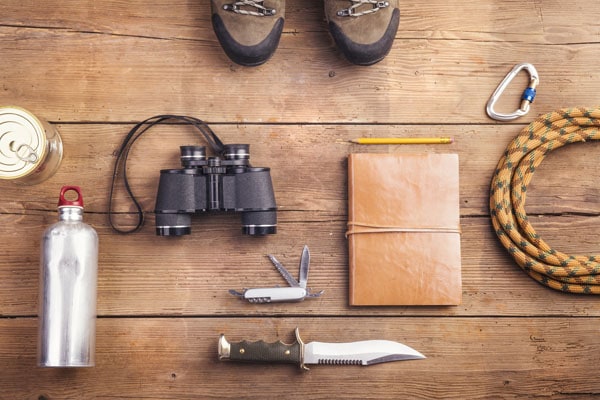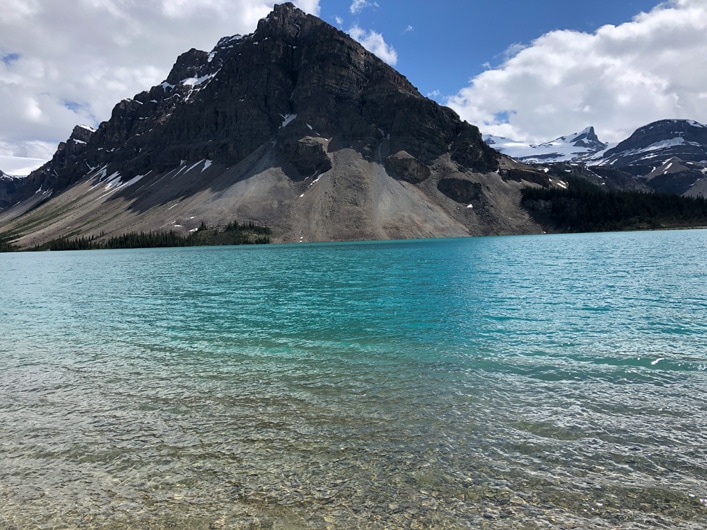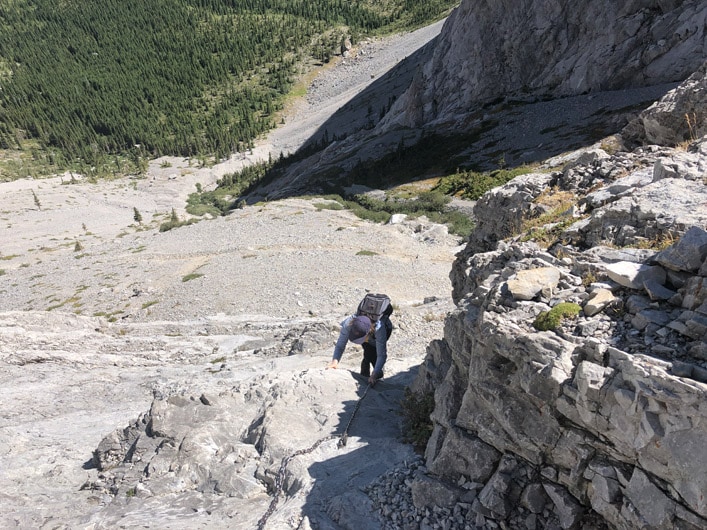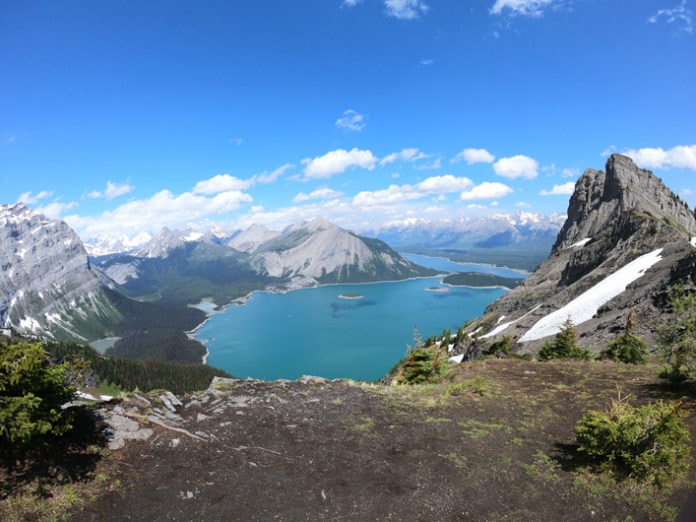Hiking is a great way to take a break from busy city life, get in shape, and explore nature around you.
It is also a great way to take a lot of cool Instagram worthy shots…
You don’t need to have any special skills to start hiking and there are trails for everyone.
Being in a decent physical shape can help you to progress from hiking easy introductory trails to hiking more challenging terrain but it is definitely not a requirement as long as you don’t overestimate your abilities and skill level.
Hiking can easily be done on a budget especially if you are just starting and only planning to do day trips for now.
What to Bring for Your First Hiking Trip?

1. Proper footwear
Hiking boots or shoes are awesome but if you are just starting out and planning to hike only beginner’s trails you can get away with the sneakers.
However, for intermediate and difficult trails it is safer to hike in hiking boots.
Hiking boots have better traction and will help you not to slip when hiking steeper trails.
They also provide much better foot and ankle support than sneakers.
My advice is to start with sneakers if you already have them and not to invest in hiking boots until you do a few easy hikes to see if you actually enjoy hiking.
2. Hiking pants and a rain jacket
Hiking pants and a rain jacket can make your hike much more comfortable especially if you are planning to do longer hikes high in the mountains where the weather changes several times per day.
I also like to bring extra clothes just in case it gets cold.
Here in Canada, you can encounter snow any month of the year when hiking high in the mountains.
You should always keep in mind that there is a temperature drop as you gain elevation while hiking.
The rough rule of thumb is a 1° Celsius decrease in temperature for every 100m of elevation gain.
3. Backpack
A backpack is the easiest way to carry all your gear, extra clothes, food, and water.
If you can, try to get a waterproofed backpack.
Alternatively, carry a plastic bag that you can use to put all your dry stuff in case it starts to rain.
4. Bear spray
If you are hiking in bear country, always bring a bear spray and know how to use it.
In some situations, it can save your life.
5. Map or GPS
Unless you are familiar with a trail you are planning to hike, it is important to do research beforehand and have some type of map or GPS to locate the trail.
It is not fun and can be dangerous to get lost in the forest while hiking in the mountains.
Reception is not always available on many hiking trails so don’t rely on the Internet for navigation.
I use a premium version of AllTrails that allows you to download offline maps and use your phone’s GPS to follow the trail.
This way you don’t need to buy any extra navigational gear.
6. First aid kit
Have a small first aid kit with you.
Cuts and small bruises are very common when hiking so you might find bandages and antiseptic pretty handy.
7. Sun protection
The sun is usually much stronger in the mountains and it is essential to protect yourself from harmful UV rays.
If you hike in the summer, don’t forget to bring your sunglasses and a hat.
8. Bug spray
You will likely encounter all kinds of blood-sucking insects like mosquitoes and horse flies when hiking so it might be a good idea to bring some protection just in case.
9. Water and snacks
It is important to stay properly hydrated when hiking because you will be losing a lot of fluids, especially if hiking during the hot summer months.
Equally important is to have some kind of snacks with you.
Even if you don’t plan to eat it, bring it just in case your hike will take longer than expected.
10. Hiking poles
Hiking poles are very useful if you are doing more challenging steep hikes.
11. Knife, lighter/matches, and a flashlight
In case you get lost, you want to have at least some basic tools that might be helpful if you have to stay in the forest overnight.
Solo Hiking Tips for the Beginners

It is always better to hike in a group especially if you are new to hiking.
But what can you do if your friends are not into hiking?
In that case, solo hiking might be your only option unless you join a meetup group.
There are a lot of people that hike solo both males and females so you are not going to be the only solo hiker on a trail.
Some hikers actually enjoy solo hiking because it allows them to relax and hike at their own pace.
However, keep in mind the tips below when hiking by yourself.
12. Tell someone about your hiking plans
Let them where are you going and when you are planning to be back. It also a good idea to check in with them every few hours.
13. Use hiking apps to keep someone at home informed
Some apps like AllTrails have a lifeline function that can keep your family or friends informed while you are hiking but this requires a cell signal.
14. Hike popular trails
It is safer to hike busier trails where you will meet a lot of other hikers. This way if you run into any problems, you will be able to ask for help.
15. Make noise when hiking to avoid surprising bears
Some hikers like to carry Bluetooth speakers when hiking alone. Or you can just use the speaker on your phone as long as you have enough battery.
16. Don’t wear headphones when hiking
I saw a lot of solo hikers wearing headphones and I personally don’t see how it can be safe. Don’t you want to hear if there is a bear behind you?
17. Invest in a satellite phone
If you are always hiking solo it might be worth investing in a satellite phone.
How Do You Plan a Hike?

Depending on where you live you might have a lot of options when choosing the right trail for your hike.
18. Use social media to find new trails
I like to use Instagram, YouTube, and Facebook to get ideas for my upcoming hiking trips.
You can use hashtags to find photos and videos taken by your local hikers.
After you find the name of the hike you like, Google for the trail directions.
19. Use AllTrails or a similar app to research trails
AllTrails is a great tool for finding new trails and researching what other people say about the hike.
It is also a great app to see technical info about the trail like length, elevation gain, the time required to complete the hike, and difficulty level.
20. Plan your drive and estimate your arrival time
If you are planning to go on a longer hike try to arrive early so that you can finish the hike before it gets dark.
Arriving early in the morning will also help you to avoid any parking issues if you choose a busy trail.
Top Hiking Mistakes to Avoid

21. Not researching the trail before going for a hike
Many trails are not marked and might not even have a parking lot.
22. Not wearing hiking shoes or boots when hiking harder trails with loose rocks
Your gym shoes are probably fine for easy hikes with small elevation gain.
However, if you are hiking steep rocky terrain, you will need something with much better traction to avoid slipping and hurting yourself.
23. Underestimating how much time it will take to complete the trail
There are many factors that can influence your hiking time so be prepared to finish a few hours later than expected.
24. Hiking during bad weather conditions
Extreme weather can make hikes very dangerous. There is no shame in ending your hike early if the weather is not cooperating.
25. Overestimating your abilities
If you are a beginner hiker it is probably a good idea to take time and do a few easy and intermediate trails before hiking more difficult trails with high elevation gain.
26. Taking shortcuts while hiking (bushwhacking)
It might be tempting to take shortcuts while hiking to get to your destination faster but it is also the easiest way to get lost. I am guilty of this myself…
Other Tips for Beginner Hikers

27. Be prepared for bear encounters
Stay calm and don’t run away when you encounter a bear. Playing dead and showing him that you are not a threat that can prevent an attack.
However, always have your bear spray ready in case the bear decides to attack.
Fortunately, bear attacks are rare and usually happen when the hikers surprise a mama bear with her cubs.
Never approach a bear to take pictures. Always give bear enough space when hiking.
28. Make sure your vehicle can handle the road
Not all of the roads are paved and in some more extreme cases, you might need a 4×4 vehicle especially in the winter.
It is also important to ensure that you have enough gas to get back. Gas stations are not very common in the wilderness.
29. Be aware of avalanches
If you hike in the winter, pay attention to avalanche warnings.
Every winter people die in avalanches so stay safe and invest in safety gear if you are planning to hike a lot in avalanche country.
30. Be careful when taking photos
You don’t want to lose your footing when taking selfies and end up in the river or fall down the cliff.
Did you know that your internet service provider can track your online activity? Want to hide your identity online and keep your browsing habits private? Try NordVPN!
*This post might contain affiliate links. If you click on a link, I might receive a small commission.

